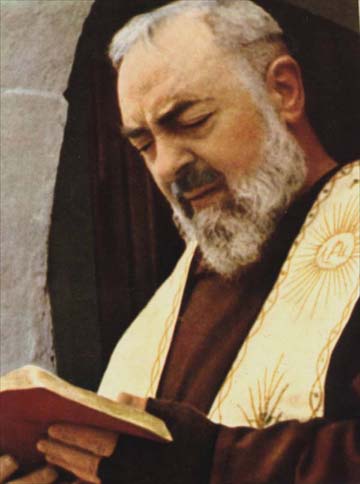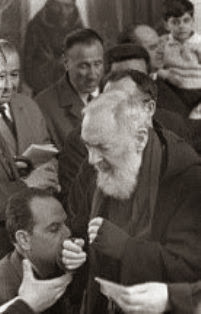
Padre Pio Foundation
This site is dedicated to the life and work of Padre Pio.
|
|
Padre Pio Padre Pio is now Saint Padre Pio. Padre Pio was canonized by Pope John Paul II on June 16, 2002. For many years in the past, thousands of people have climbed up the mountain path in San Giovanni Rotondo, Italy, to visit the great Padre Pio, or at least see Padre Pio, the famous stigmatized Capuchin monk. Padre Pio was the first priest in the history of the Catholic Church to bear the holy wounds of Jesus Christ. Padre Pio was born in the village of Pietrelcina, Italy, on May 25, 1887. Padre Pio's parents gave him the name of Francesco Forgione. There were eight children in total, three of whom died in infancy. Padre Pio's parents were simple hard working farmers. They were so poor, that Padre Pio's father Orazio went to the United States twice, in order to be able to provide for his family and earn enough money to educate Padre Pio for the priesthood. As a child, Padre Pio avoided the company of other children, and did not take part in their games. Padre Pio had a great horror of sin and cried when he heard anyone blaspheming, or taking Godís name in vain. Even when Padre Pio was seven years old, Padre Pio could tell if somebody was in the state of sin. From the time Padre Pio was a child, Padre Pio would often think about the things of God and keep himself recollected.
Padre Pio Articles
|
Please help the Padre Pio Foundation in this world of pain and hunger Please donate. Thank you. |
Padre Pio History
VATICAN CITY (AP) - A mystic monk who won adulation from rank-and-file Roman Catholics but scorn from the Vatican during his lifetime will be made a saint Sunday by Pope John Paul II, a longtime admirer who once sought the priest out as his confessor.
The honor for Padre Pio, an Italian Capuchin who died in 1968, fits into the pontiff's quest for models of unquestioning belief and obedience in recent, faith-testing times.
Hundreds of thousands of fans of Pio are expected to flock to St. Peter's Square on Sunday for the canonization of the monk whose palms bled inexplicably for decades like the wounds of the crucified Christ.
Doubted and rejected by many in the Vatican for much of his life, and accused by detractors of being a fraud, Padre Pio persisted in his life's labor of prayer while his popularity among lay Catholics grew wildly.
Italian celebrity magazines sold briskly when Pio was on the cover instead of the usual photo of a sexy star.
His reputation spread abroad. While a simple priest, Karol Wojytla journeyed from Poland to Puglia, in southeastern Italy, to be confessed by Padre Pio. As pontiff, John Paul prayed at Pio's underground tomb at the monk's sanctuary, San Giovanni Rotondo, which now rivals Lourdes, France, as a pilgrimage site.
For John Paul, "here is somebody who demonstrates the possibility of sanctity, when the forces of industrialization, modern life, modern agnosticism and totalitarianism have seemed to eclipse that possibility," said historian R. Scott Appleby, who directs a center studying American Catholicism at the University of Notre Dame.
In May 1999, the pope beatified Pio, the last formal step toward sainthood. After that, one miracle was needed to clinch canonization, and believers had only to wait eight months.
A little boy, the son of a doctor who works in a hospital Pio founded in San Giovanni Rotondo, awoke from a coma triggered by meningitis. Doctors consulted by the Vatican concluded that Matteo Pio Colella's recovery had no scientific explanation.
"The doctors gave him up as a lost cause. I entrusted him to Pio," said Matteo's mother, Maria Lucia Ippolito, as her son, dressed up like a little monk, rehearsed at the Vatican in early June for a musical about Pio.
A Capuchin priest who formally argued the cause of sainthood at the Vatican, the Rev. Forio Tessari, said it was Padre Pio's uncomplaining life of pain which impressed John Paul, who is now 82 and struggling to continue in the papacy despite physical frailty and difficulty in walking and speaking, symptoms of Parkinson's disease.
"The pope was struck above all by the spiritual figure of Padre Pio, a man who had a strong experience of God, who prayed, suffered in silence, obeyed his superiors with faith," said Tessari.
Some of Pio's silence was imposed by Vatican officials wary about his mysticism.
Born Francesco Forgione in 1887 in a small town near Naples, he had a vision when he was 15, entered religious life and took the name "Pio," which means pious in Italian. In 1910, hours after celebrating his first Mass, Padre Pio reported pain in his feet and hands, a foreshadowing of the bleeding he was to report a few years later.
Pio was considered the first priest in centuries to bear the signs of the stigmata, the wounds that Christ suffered in his hands, feet and side at crucifixion.
In the 1920s, the Vatican expressed doubts about the supernatural nature of the wounds and ordered him to stop celebrating Mass in public, a ban that would last a decade.
Some in the Church hierarchy wondered if Pio caused the wounds himself by perhaps pouring acid on them.
Pio would hear confessions, for hours, to the point of exhaustion, gratefully taking the candies faithful would offer him to moisten his parched throat. Two friars once bugged his confessional to see if he was a fake. Pio emerged unscathed.
Skeptics in the Vatican were eventually won over, said Tessari.
Cardinal Jose Saraiva Martins, the prelate who oversaw the canonization process, has played down the earlier Vatican skepticism, saying in an interview this spring in Specchio, a magazine of La Stampa newspaper, that "the Church has its rhythms and its procedures to ascertain the heroism of Christian life."
Those rhythms started speeding up under John Paul, who has sought to rejuvenate faith among Catholics by raising a record-number of figures (461) to sainthood in his 24 years at the helm.
Said Appleby: "This pope is driven by a sense of urgency, not just by his own mortality, but by the urgency of the condition of humanity" to rapidly raise up figures as Christian models.
Faithful gather as remains of StigmataSaint Padre Pio go on display |
|
|
|
|
|||
|

